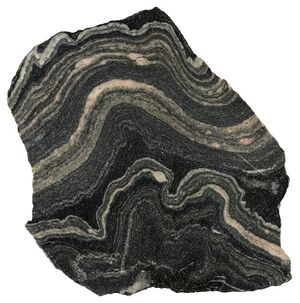Gneiss
Characteristics
Gneiss can't be defined on the minerals present within the rock. Gneiss can be recognized by the organization of minerals that form into bands in the rock. This happens because of the clay minerals present. Gneiss originate from regional metamorphism at convergent plate boundaries, which mean it forms under high pressure and high temperature conditions.
Gneiss can be easily mistaken for schist or granite. They can be held apart by looking at the cleavage. Breaking a gneiss generates splinters of centimeters thick and schist breaks down in splinters of only millimeters thickness. It can be held apart from granite via its origin and texture. Granite originates from solidified magma and gneiss from recrystallization of existing rock. The minerals in gneiss have a certain preferable orientation due to the fact that it contains clay minerals. Granite doesn't have this preferable orientation.
Composition
As said in the previous paragraph gneiss can be recognized by its mineral composition. However, gneiss has some minerals which are always present. These minerals are feldspar and quartz creating the interlocking band structure. These bands are usually light in color and alternate with bands of darker-colored minerals with elongate habits, like for example clay minerals.
References
- https://geology.com/
- NEN-EN-ISO 14688-1:2019
Gneiss

| Type | Metamorphic rock |
|---|---|
| Texture | Banded |
| Clasts | Can be present |
| Hardness | Very hard |
| Color | Grey to dark grey |
| Minerals | Quartz or feldspar and clay minerals |
| Touch | Rough |
| Image | Gneiss |